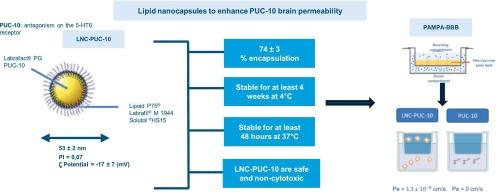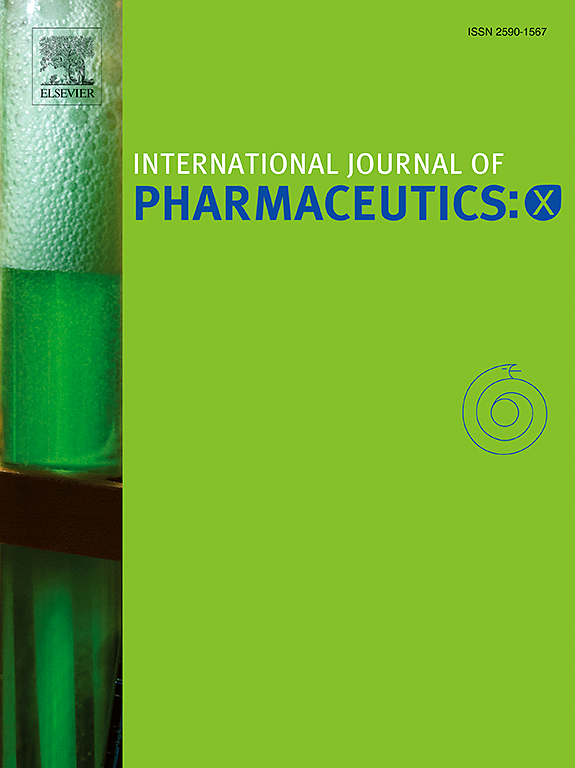设计创新型纳米载体,提高新型 5-HT6 受体拮抗剂的脑渗透性
IF 5.2
2区 医学
Q1 PHARMACOLOGY & PHARMACY
引用次数: 0
摘要
我们设计了一种基于脂质纳米囊(LNC)的创新纳米载体,以促进新型 5-HT6 受体拮抗剂 PUC-10 通过血脑屏障。PUC-10 是一种新合成的 N-芳基磺酰基吲哚类药物,具有强效的 5-HT6 受体拮抗剂活性,但在水中的溶解度较低,这表明其吸收能力有限。所设计的脂质纳米胶囊具有纳米级尺寸(53 纳米)、单模分布(PI<0.2)、负 Z 电位(-17 ± 7 mV),可有效封装 PUC-10(74%)。此外,LNC 在 4 °C(储存条件)下至少稳定 4 周,在 pH 值为 7.4 的 DMEM 中至少稳定 4 小时,在含有 5 % DMSO 的水中稳定 18 小时,后两种条件均保持在 37 °C。他们还证明,在研究的不同浓度下,细胞活力均未受到影响。最后,模拟血脑屏障(PAMPA-BBB)的体外研究表明,PUC-10 的纳米包囊促进了其在血脑屏障中的渗透,计算出的渗透率为 1.3 × 10-8 厘米/秒,而非纳米包囊的 PUC-10 的渗透率为零。本文章由计算机程序翻译,如有差异,请以英文原文为准。

Design of an innovative nanovehicle to enhance brain permeability of a novel 5-HT6 receptor antagonist
An innovative nanovehicle based on lipid nanocapsules (LNC) was designed to facilitate the passage of a new 5-HT6 receptor antagonist, namely PUC-10, through the blood-brain barrier. PUC-10 is a new synthetic N-arylsulfonylindole that has demonstrated potent 5-HT6 receptor antagonist activity, but it exhibits poor solubility in water, which indicates limited absorption. The lipid nanocapsules designed had a nanometric size (53 nm), a monomodal distribution (PI<0.2), a negative Z potential (−17 ± 7 mV) and allowed efficient PUC-10 encapsulation (74 %). Furthermore, the LNC demonstrated to be stable for at least 4 weeks at 4 °C (storage conditions), for at least 4 h in DMEM at pH 7.4, and for 18 h in water with 5 % DMSO, with both latter conditions maintained at 37 °C. They also demonstrated that cell viability was not affected at the different concentrations studied. Finally, in vitro studies that simulate the blood brain barrier (PAMPA-BBB) demonstrated that the nanoencapsulation of PUC-10 promoted their penetration through the blood-brain barrier, with a calculated permeability of 1.3 × 10−8 cm/s, compared to the null permeability exhibited by non-nanoencapsulated PUC-10.
求助全文
通过发布文献求助,成功后即可免费获取论文全文。
去求助
来源期刊

International Journal of Pharmaceutics: X
Pharmacology, Toxicology and Pharmaceutics-Pharmaceutical Science
CiteScore
6.60
自引率
0.00%
发文量
32
审稿时长
24 days
期刊介绍:
International Journal of Pharmaceutics: X offers authors with high-quality research who want to publish in a gold open access journal the opportunity to make their work immediately, permanently, and freely accessible.
International Journal of Pharmaceutics: X authors will pay an article publishing charge (APC), have a choice of license options, and retain copyright. Please check the APC here. The journal is indexed in SCOPUS, PUBMED, PMC and DOAJ.
The International Journal of Pharmaceutics is the second most cited journal in the "Pharmacy & Pharmacology" category out of 358 journals, being the true home for pharmaceutical scientists concerned with the physical, chemical and biological properties of devices and delivery systems for drugs, vaccines and biologicals, including their design, manufacture and evaluation. This includes evaluation of the properties of drugs, excipients such as surfactants and polymers and novel materials. The journal has special sections on pharmaceutical nanotechnology and personalized medicines, and publishes research papers, reviews, commentaries and letters to the editor as well as special issues.
 求助内容:
求助内容: 应助结果提醒方式:
应助结果提醒方式:


